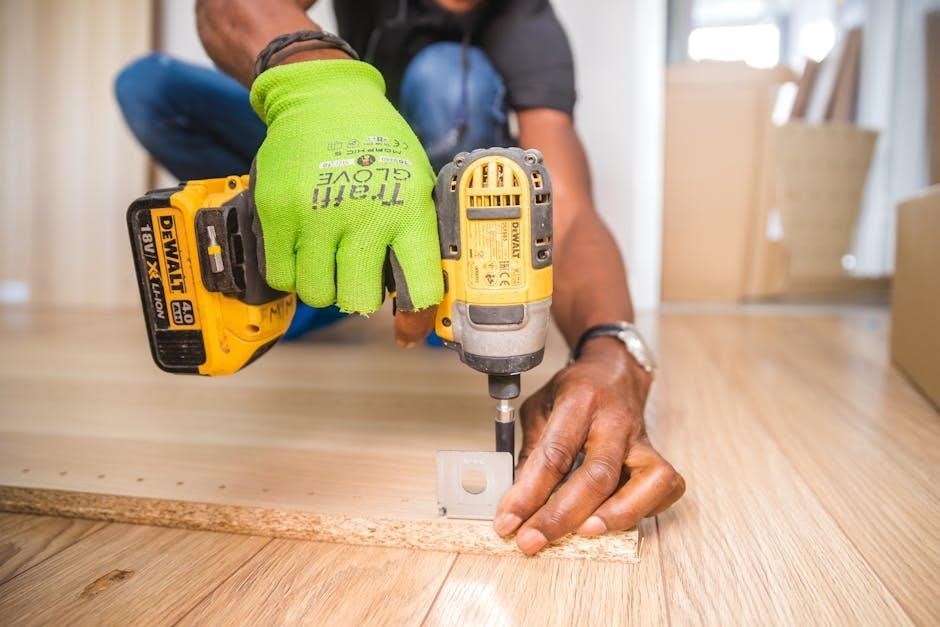Understanding Pocket Hole Screws

Pocket hole screws are essential for strong, hidden joints in woodworking. Their length and diameter must match material thickness for optimal strength and durability in various projects.

Pocket hole screws are a popular choice for woodworking projects due to their strength and ease of use. They are designed to create hidden joints, making them ideal for furniture, decking, and other applications where aesthetics matter. These screws feature an angled shank that allows them to securely fasten two pieces of wood together without visible hardware. Their versatility makes them suitable for both beginners and professionals, simplifying the assembly process. The length and diameter of pocket hole screws are critical factors, as they must match the material thickness to ensure a sturdy joint. Properly selected screws enhance the durability and stability of the project, making them a reliable option for various woodworking needs; Understanding their design and application is essential for achieving professional-looking results.
Types of Pocket Hole Screws
Pocket hole screws come in various types to suit different woodworking needs. The most common are coarse-thread and fine-thread screws. Coarse-thread screws are ideal for thick, dense materials like solid wood, providing strong hold. Fine-thread screws, with their smaller threads, are better suited for thinner or softer materials, such as plywood, to prevent splitting. Additionally, screws differ in coatings, with options like zinc-plated or stainless steel for durability in outdoor applications. Their lengths and diameters vary, allowing woodworkers to choose the right screw for specific projects. Understanding these types ensures proper material compatibility and joint strength, enhancing the overall quality of the work. Each type is designed to optimize performance in different scenarios, making them versatile tools for a wide range of woodworking tasks. Proper selection is key to achieving durable and professional-looking results.

Choosing the Right Screw Length
Selecting the correct screw length ensures strength and prevents material damage. Proper length balances joint integrity and avoids over-penetration, crucial for stability and durability in woodworking projects.


Factors Influencing Screw Length Selection
Choosing the right screw length involves considering material thickness, project type, and load-bearing requirements. Thicker materials need longer screws for stability, while thinner materials require shorter ones to avoid splitting. The intended use of the project also plays a role; for example, shelves or heavy furniture may need longer screws for added strength. Additionally, the type of wood and its density can affect screw length, as denser woods may require slightly shorter screws to prevent over-penetration. Ensuring the screw engages fully without exiting the other side is crucial for joint integrity and durability. Proper alignment and drilling techniques further enhance the effectiveness of the selected screw length, making it a critical factor in successful pocket hole joinery.

Material Thickness and Screw Size
Material thickness is a critical factor in selecting the appropriate screw size. Pocket hole screws must be long enough to securely hold the joint without protruding from the other side. For example, 1.25″ screws are ideal for 3/4″ thick wood, while 2″ screws are better suited for 1.5″ thick materials. Using screws that are too short may result in a weak joint, while screws that are too long can damage the material or interfere with the project’s design. The screw’s outer diameter should also match the hole drilled, ensuring proper alignment and strength. Always consult a screw length guide to ensure compatibility with your project’s specific requirements. Proper sizing ensures maximum stability and prevents common issues like splitting or inadequate hold. This balance is essential for achieving professional-grade results in woodworking projects.

Common Screw Lengths and Diameters
Common pocket hole screw lengths range from 1″ to 3″, with 1.25″ and 2″ being the most frequently used. Diameters typically range between 6mm and 8mm, ensuring proper fit and strength in various materials.
Standard Screw Lengths for Different Projects
For thin materials like 1/2″ plywood, 1″ screws are ideal, preventing over-penetration. Medium-thickness projects, such as 3/4″ stock, often use 1.25″ screws for balanced strength. Thicker materials, like 1.5″ or 2″ stock, benefit from 2″ to 2.5″ screws to ensure durability. Adjusting screw length based on material thickness ensures joints are strong without compromising the workpiece. Proper selection prevents screws from protruding or splitting the wood. Always consider the specific project requirements when choosing screw lengths to achieve optimal results and avoid common issues like stripped holes or weakened joints. Using the correct screw length enhances the structural integrity and longevity of the finished piece, making it safer and more professional-looking. Proper planning and measurement are key to selecting the right screw length for any woodworking project.
Importance of Proper Screw Diameter
The diameter of pocket hole screws plays a crucial role in ensuring strong and durable joints. A screw that is too small may not provide sufficient strength, while one that is too large can split the material. Standard diameters, such as #7 and #8 screws, are commonly used for most woodworking projects due to their balanced strength and compatibility with typical materials. Proper diameter selection ensures the screw can securely hold the joint without causing damage to the workpiece. It also prevents the screw from slipping or loosening over time. Choosing the right diameter is essential for achieving professional-looking results and ensuring the structural integrity of the project. Always match the screw diameter to the material thickness and project requirements for optimal performance and longevity.

Drilling and Installation Tips
Accurate drilling and proper installation are critical for strong joints. Use a pocket hole jig for precise hole alignment and clamp it firmly to prevent errors during drilling. Ensure screws seat properly for optimal strength and durability in your projects.
Drilling Accurate Pocket Holes
Drilling accurate pocket holes is crucial for successful joint assembly. Start by using a purpose-built pocket hole jig, which ensures consistent hole placement and angle. Clamp the jig firmly to your workpiece to prevent movement during drilling. Set the drill bit depth to match the thickness of your material, as specified by the jig or manufacturer. Use a sharp drill bit to avoid splintering, especially in thin materials. For thicker materials, consider using a backing board to further minimize splintering. Always drill at the correct angle, typically 15 degrees, to allow the screw to seat properly without splitting the wood. Properly aligned holes ensure screws will hold securely, making your project sturdy and long-lasting. Keep the drill steady and apply consistent pressure to maintain accuracy and avoid mistakes.

Best Practices for Screw Installation
Proper screw installation is vital for ensuring strength and durability in pocket hole joints. Always use a screw that matches the material thickness and hole diameter for optimal results. Begin by clamping the workpieces securely to maintain alignment during assembly. Use a screwdriver or drill with a Phillips bit to avoid stripping the screw head. Apply steady, consistent pressure to prevent the screw from slipping out of the hole. Drive the screw until it is snug but not over-tightened, as this can cause the material to split. For dense or hardwood materials, consider pre-drilling a pilot hole to avoid splitting. Ensure the screw is seated properly within the pocket hole, leaving enough clearance for the joint to close tightly. Finally, inspect the joint to confirm proper alignment and screw placement before moving on to the next piece.
Choosing the correct screw length and following proper installation techniques ensures strong, durable joints in woodworking projects, making pocket hole screws a reliable choice for craftsmen of all levels.
Final Thoughts on Pocket Hole Screw Length
Selecting the appropriate pocket hole screw length is crucial for ensuring strong and durable joints in woodworking projects. Proper screw length ensures the screw engages thoroughly with the material without over-extending, which can weaken the joint or cause splitting. Material thickness plays a significant role in determining the ideal screw length, as screws that are too short may not provide sufficient strength, while screws that are too long can protrude or damage the surrounding material. Always consider the specific requirements of your project, such as load-bearing capacity and material type, to choose the right screw length. Using a pocket hole jig and following manufacturer guidelines will help achieve accurate and reliable results. By paying attention to these details, you can ensure professional-quality joints that enhance the durability and longevity of your woodworking creations.